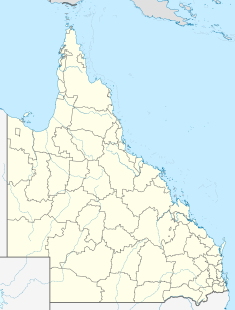Rockton, Ipswich
| Rockton | |
|---|---|

Residence in 2015
|
|
| Location | Rockton Street, Newtown, City of Ipswich, Queensland, Australia |
| Coordinates | 27°36′58″S 152°46′20″E / 27.6162°S 152.7721°ECoordinates: 27°36′58″S 152°46′20″E / 27.6162°S 152.7721°E |
| Design period | 1840s - 1860s (mid-19th century) |
| Built | 1855 - |
| Official name: Rockton | |
| Type | state heritage (built, landscape) |
| Designated | 21 October 1992 |
| Reference no. | 600552 |
| Significant period | 1850s, late 19th century, c. 1900 (fabric) 1850s (historical) |
| Significant components | carriage way/drive, trees/plantings, wall/s, garden - bed/s, swimming pool, fernery, ballroom, residential accommodation - main house, garden/grounds, billiards room |
Rockton is a heritage-listed villa at Rockton Street, Newtown, City of Ipswich, Queensland, Australia. It was built from 1855 onwards. It was added to the Queensland Heritage Register on 21 October 1992.
Rockton is a substantial brick house, the first section of which was built as a cottage for bank manager William Craies and his wife Sabina in 1855. The cottage was progressively extended and altered by successive owners over a long period, producing a complex but surprisingly harmonious house with great character.
In the 1850s, Craies was commuting between Ipswich and Brisbane as manager of the branches of the Bank of New South Wales in both towns. He then resigned and came to work full-time in Ipswich as a partner with the merchant Walter Gray and Co. To quickly provide accommodation for his family in Ipswich, he built a three room cottage in 1855 on 7ha of land he already owned on Limestone ridge overlooking the town. The cottage faced north, had two fireplaces, a boxroom at each end and a verandah back and front. Behind it to the south was a detached kitchen and bath house.
The cottage was extended within the year by builder William Hancock. Craies sold the house in 1862 because of financial difficulties associated with the collapse of Walter Gray and Co and it was then described as "a good substantial edifice built of bricks with shingled roof and containing front and side and back verandahs, entrance hall, dining room, drawing room, four bedrooms, nursery, pantry, store-room, kitchen, servants room and wash house." There were also several outbuildings, a lawn, garden and kitchen garden, a vineyard of 2000 vines and paddocks for horses and a cow. At this time, the house was considered to be a "country residence", although only 2 km from the centre of Ipswich. The purchaser was Robert Towns who rented it. The next owner, in 1873, was Samuel Hodgson.
The house was occupied by the Bullmore family in 1877 and purchased by them in 1882, after which it was again extended. The Bullmores had several daughters who attended the nearby Ipswich Girls' Grammar School after it was established in 1892 and the house was extended for family accommodation and entertaining. A breezeway between two wings was enclosed to form a ballroom and an upper storey was added to the northern end with a "widow's walk" on top. About 1900, the roof was changed to corrugated galvanised iron, a verandah was built onto the upstairs section on the north side and a tower was built, possibly designed by George Brockwell Gill. Bullmore was notable for his establishment of Trelawney Dairy near Harrisville which had associated butter and cheese factories.
...
Wikipedia


